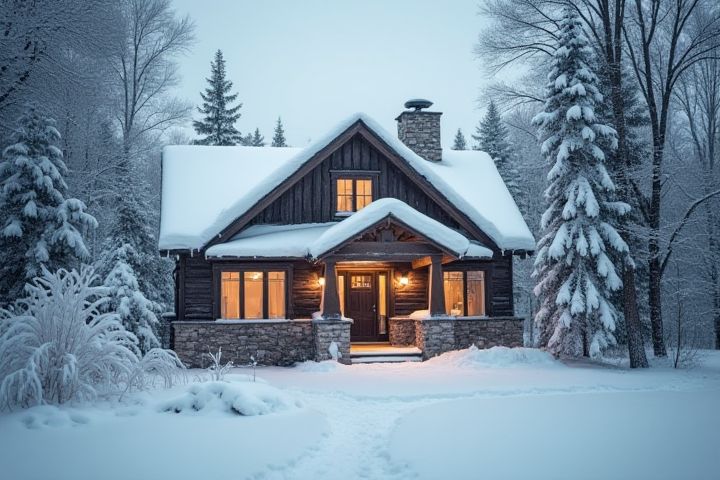
To prepare your house for winter, start by inspecting and sealing windows and doors to prevent drafts, using weather stripping or caulk as necessary. Ensure your heating system is functioning efficiently by scheduling maintenance or replacing filters, which will improve indoor air quality and reduce energy costs. Insulate pipes to avoid freezing and bursting, especially those in unheated areas like basements or attics. Don't forget to clean gutters to prevent ice dams, and check the roof for missing shingles or leaks before snowfall. Lastly, stock up on supplies like salt for walkways and extra blankets in case of severe weather, ensuring your home remains safe and comfortable.
How To Get A House Ready For Winter
Inspect and seal windows and doors.
Inspecting and sealing windows and doors is crucial for ensuring your home remains energy-efficient during the winter months. Begin by checking for drafts; you can use a candle or incense stick to detect air leaks around frames. If you identify gaps, consider applying weather stripping or caulk to seal them effectively, enhancing insulation and reducing heating costs. Taking these steps will not only keep your space warmer but also increase your home's overall comfort and energy efficiency throughout the cold season.
Clean gutters and downspouts.
Cleaning your gutters and downspouts is essential for winter preparedness, as clogged gutters can lead to ice dams and water damage. Start by removing leaves, twigs, and debris to ensure proper water flow; a leaf blower or gutter scoop can be helpful tools in this process. Once cleared, inspect downspouts for blockages, ensuring they direct water away from your foundation to prevent freezing issues. This proactive maintenance will not only protect your home's exterior but also contribute to a more efficient drainage system during the winter months.
Check and service the heating system.
Check and service your heating system to ensure optimal performance during the winter months. Schedule a professional inspection of your furnace, boiler, or heat pump, as regular maintenance can prevent costly breakdowns and improve energy efficiency. Replace dirty filters and clean vents to enhance airflow, which aids in maintaining consistent temperatures throughout your home. Consider adding a programmable thermostat to regulate your heating system, allowing you to save on energy costs while keeping your living space warm and comfortable.
Insulate pipes and exterior faucets.
To prepare your home for winter, insulate your pipes and exterior faucets to prevent freezing and potential damage. Use foam pipe insulation or wrap insulation tape around exposed pipes, especially those in unheated areas like basements or attics. For exterior faucets, consider installing insulated covers, which can maintain temperatures above freezing and protect your plumbing system. By taking these measures, you can save on costly repairs and ensure your home remains safe and efficient during the colder months.
Trim overhanging branches near the house.
Trim overhanging branches to prevent potential damage to your house during winter storms. This reduces the risk of branches breaking under the weight of snow or ice and impacting your roof or windows. Inspect trees surrounding your property, ensuring they are healthy and pruned to avoid hazards. Regular maintenance not only enhances the aesthetics of your landscape but also protects your home's structural integrity and safety throughout the cold months.
Test and replace smoke and carbon monoxide detectors.
To prepare your house for winter, start by testing and replacing smoke and carbon monoxide detectors to ensure they function correctly throughout colder months. Regularly check that the batteries are fresh, and consider upgrading to models with longer-lasting lithium batteries if necessary. If your detectors are over ten years old, replace them entirely to enhance your safety. Keeping your detectors in optimal condition can significantly reduce fire risks and protect your family from carbon monoxide poisoning during winter.
Reverse ceiling fan direction for better heat circulation.
To prepare your house for winter, adjusting your ceiling fans to reverse direction is crucial for optimal heat circulation. By setting the fans to run clockwise, warm air, which naturally rises, is pushed down into the living space, ensuring that your rooms remain cozy. This simple adjustment can enhance your heating efficiency, potentially lowering energy costs during colder months. You can easily switch your fan direction with a pull chain, a wall switch, or a remote control, making it a quick and effective winter preparation task.
Check roof for damage and repair if needed.
Inspecting your roof for damage is essential to preparing your house for winter. Look for missing shingles, cracks, or signs of leakage, as these could lead to more significant issues once the snow and ice accumulate. If you identify any problems, prioritize repairs promptly to prevent further deterioration, which can save you thousands of dollars in water damage. Regular maintenance, such as clearing debris from gutters, can also enhance your roof's longevity and performance during harsh winter weather.
Review and update emergency supplies.
Reviewing and updating your emergency supplies is essential for winter preparedness. Start by checking your stock of non-perishable food items, ensuring they are fresh and accessible, as well as bottled water in case of severe weather. Include necessities such as flashlights, batteries, and a first-aid kit; these can be lifesavers during power outages. You should also assess your heating sources, ensuring extra blankets and fuel supplies are on hand to keep your household warm and safe throughout the colder months.
Store outdoor furniture and equipment safely.
To prepare your house for winter, securely store outdoor furniture and equipment in a dry, sheltered location, reducing exposure to harsh weather conditions. Use waterproof covers for items that remain outside, ensuring protection against snow and rain damage. If disassembling larger furniture is possible, take advantage of this space-saving approach to protect them from wear. Additionally, check and clean garden tools, storing them in a designated area to prevent rust and prolong their lifespan.
